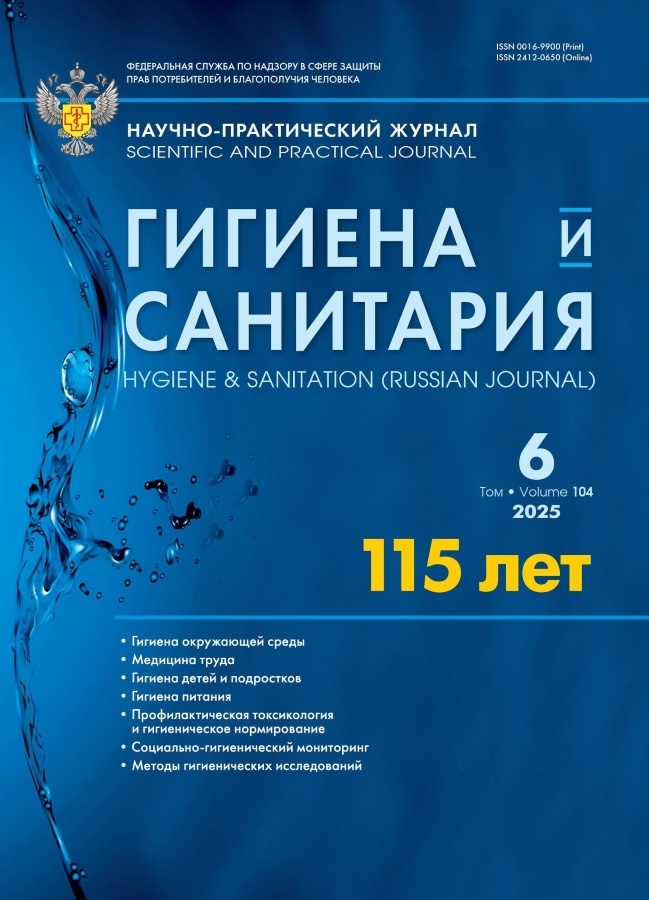Comparative assessment of the combined action of chlorsulfuron-based pesticides
- Authors: Bagreev A.Y.1, Rakitskiy V.N.1, Kuzmin S.V.1
-
Affiliations:
- Federal Research Center of Hygiene named after F.F. Erisman
- Issue: Vol 104, No 6 (2025)
- Pages: 767-771
- Section: PREVENTIVE TOXICOLOGY AND HYGIENIC STANDARTIZATION
- Published: 15.12.2025
- URL: https://modernonco.orscience.ru/0016-9900/article/view/691567
- DOI: https://doi.org/10.47470/0016-9900-2025-104-6-767-771
- EDN: https://elibrary.ru/bynjpa
- ID: 691567
Cite item
Abstract
Introduction. For several decades, herbicides have remained effective means of weed control, accounting for more than 60% of registered pesticide preparations. Among modern herbicides, combination preparations are popular. The range of combination preparations continues to increase, and currently there are more than fifty different names. Given the specific features of the joint interaction of pesticides, the requirements for their toxicological and hygienic assessment are increasing from year to year.Materials and methods. To establish the nature of the combined action of chlorsulfuron with other active substances and study the nature and degree of interaction of these substances, the method of orthogonal experimental design using probability values was used.Results. Based on the results of the studies, toxicity parameters were established and the nature and degree of interaction of various combinations of chlorsulfuron with other active substances: 2,4-D and dicamba were determined.Limitations. When choosing toxicometric parameters for chlorsulfuronic acid, the intragroup number of rats is 6–10 individuals, depending on the tasks being solved, which is a sufficient reference sample.Conclusion. The parameters of acute oral toxicity were established and the interdependent additive nature of the combined action of chlorsulfuron with other active substances was determined upon a single oral administration to the body of laboratory animals.Compliance with ethical standards. Study approved of the Ethics Committee of the Federal Research Center of Hygiene named after F.F. Erisman (Protocol of the Ethics Commission № 01/22 dated 27.20.2022). The study was conducted in accordance with the European Convention for the Protection of Vertebrate Animals used for Experimental and other Scientific Purposes (ETS N 123), Directive of the European Parliament and of the Council of the European Union 2010/63/EC of 22.09.2010 on the protection of animals used for scientific purposes.Contribution: Bagreev A.Yu. – design of the study, collection and processing of material, writing the text; Rakitskiy V.N. — research concept and design, editing. All authors are responsible for the integrity of all parts of the manuscript and approval of the manuscript final version.Conflict of interest. The authors declare no conflict of interest.Funding. The study had no sponsorship.Received: February 2, 2025 / Revised: March 3, 2025 / Accepted: March 26, 2025 / Published: July 31, 2025
About the authors
Anton Yu. Bagreev
Federal Research Center of Hygiene named after F.F. Erisman
Email: bagreev.aiu@fncg.ru
ORCID iD: 0000-0002-5226-3748
Valery N. Rakitskiy
Federal Research Center of Hygiene named after F.F. Erisman
Email: noemail@neicon.ru
ORCID iD: 0000-0002-0444-1095
Sergey V. Kuzmin
Federal Research Center of Hygiene named after F.F. Erisman
Email: noemail@neicon.ru
ORCID iD: 0000-0002-9119-7974
References
Макеева-Гурьянова Л.Т., Спиридонов Ю.Я., Шестаков В.Г. Сульфонилмочевины – новые перспективные гербициды. М.; 1989. Мирошникова Д.И., Моталова Т.В. Токсиколого-гигиеническая характеристика пестицидов на основе глифосата. В кн.: Материалы ежегодной научной конференции Рязанского государственного медицинского университета имени академика И.П. Павлова: Сборник научных трудов. Рязань; 2016: 313–6. https://elibrary.ru/xdjvnp Питина М.П., Познанская Н.Л. Использование антидотов как путь экологически безопасного применения гербицидов на основе сульфонилмочевин. Агрохимия. 1994; (4): 114–9. Janaki P., Sharma N., Chinnusamy C., Sakhtivel N., Nitya C. Herbicide residues and their management strategies. Ind. J. Weed Sci. 2015; 47(3): 329–44. Soundhia S. Herbicides residues in soil, water, plants, and non-targeted organisms and human health implications: an Indian perspective. Ind. J. Weed Sci. 2014; 46(1): 66–85 Багреев А.Ю. Комбинированное действие хлорсульфурона и 2,4-дихлорфеноксиуксусной кислоты. Гигиена, окружающая среда и риски здоровью в современных условиях. В кн.: Материалы ХIII Всероссийской научно-практической интернет-конференции молодых ученых и специалистов Роспотребнадзора с международным участием: сборник научных трудов. Саратов; 2023: 29–31. https://elibrary.ru/xudndu Мрясова Л.М., Галиахметов Р.Н., Кузнецов В.М. Снижение экологической нагрузки путем комбинирования действующих веществ при применении гербицидов на основе 2,4-Д. Башкирский химический журнал. 2009; 16(1): 103–5. https://elibrary.ru/ktwcqf Grey T.L., McCullough P.E. Sulfonylurea herbicides fate in soil: Dissipation, mobility, and other process. Weed Technol. 2012; 26(3): 579–81. https://doi.org/10.1614/WT-D-11-00168.1 Леонтьев В.Н., Ахромович Т.И., Игнатовец О.С. Естественные пути деградации гербицидов ряда сульфонилмочевины. Труды БГТУ. № 4. Химия, технология органических веществ и биотехнология. 2013; (4): 197–204. https://elibrary.ru/sobolb Li Y., Zimmerman W.T., Gorman M.K., Reiser R.W., Fogel A.J., Haney P.E. Aerobic soil metabolism of metsulfuron-methyl. Pest. Sci. 1999; 55(4): 434–45. https://doi.org/10.1002/(SICI)1096-9063(199904)55:4%3C434::AID-PS909%3E3.0.CO;2-Z Sarmah A.K., Sabadie J. Hydrolysis of sulfonylurea herbicides in soils and aqueous solutions: a review. J. Agric. Food Chem. 2002; 50(22): 6253–65. https://doi.org/10.1021/jf025575p Спиридонов Ю.Я., Раскин М.С., Кольцов Н.С., Галактионова Г.В., Сорокин В.И., Самусь М.В. и др. Гербицидный состав для зерновых культур. Патент РФ № 2028053 C1; 1995. https://elibrary.ru/kigehl Оверчук В.И., Груздев Г.С., Брусникина Н.Е., Швец Д.Г., Квасенков О.И., Сартаков А.Н. и др. Гербицидный состав для зерновых культур. Патент РФ № 2219772 C2; 2003. Ракитский В.Н. О половой чувствительности к пестицидам. В кн.: Гигиена применения, токсикология пестицидов и полимеров: сборник научных трудов. Выпуск 13. Киев; 1983: 122–4. Ракитский В.Н. Гигиенические принципы и критерии оценки опасности (риска) пестицидов. Гигиенические аспекты охраны окружающей среды и здоровья населения: сборник научных трудов. М., 1999; 169–73. The pesticide manual: A world compendium (18th edition). Hampshire, UK: British Crop Production Council (BCPC); 2018. Directive 2010/63/EU of the European Parliament and of the Council of 22 September 2010 on the protection of animals used for scientific purposes with amends by Regulation (EU) 2019/1010 of the European Parliament and of the Council of 5 June 2019. Corder G.W., Foreman D.I. Nonparametric Statistics: A Step-by-Step Approach. New York: John Wiley & Sons; 2014. Felix B.O., Senyo Y.A. Assessing univariate and multivariate normality, a guide for non-statisticians. Math. Theory Model. 2016; 6(2): 26–33. Campbell M.J., Machin D., Walters S.J. Medical Statistics: A Textbook for the Health Sciences. New York: Wiley-Blackwell; 2021. Razali N.M., Wah Y.B. Power comparisons of Shapiro-Wilk, Kolmogorov-Smirnov, Lilliefors and Anderson-Darling tests. J. Sta. Model. Anal. 2011; 2(1): 21–33.
Supplementary files









